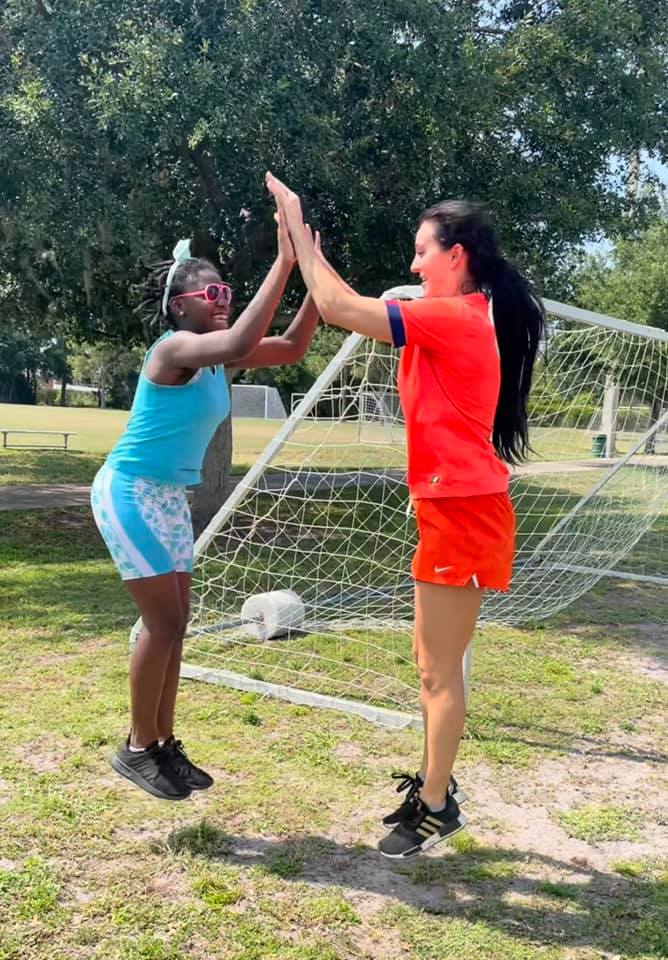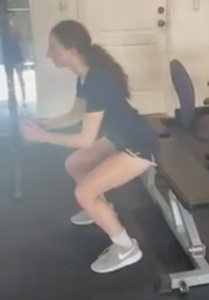
03 Jul Complete Guide to Training the Youth Female Athlete
“It’s because she’s female and has wider hips…”
This is an argument of the past. In fact, it’s so obsolete that it puts flip phones and Blackberry to shame.

The research on female athlete performance and injury reduction has evolved so much beyond the “it’s because she’s female” statement.
Yes, girls have a higher likelihood of injury because of wider angle from hip to knee, thus resulting in different lower body biomechanics than males:
- More hip internal rotation
- More knee abduction
- More outward turning (eversion) of the ankle
Since we cannot surgically change the structure of the Q angle (ouch, that would hurt!), all we can do is help female athletes focus on what they can control.
The ‘it’s because she’s female’ is a defeating statement, as if there is no control a girl has in reducing chance of injury. A female athlete does have control, and she can stack the odds in her favor by focusing on resistance training, proper nutrition, and tracking her menstrual cycle.
The 'it's because she's female' is a defeating statement, as if there is no control a girl has in reducing chance of injury. A female athlete does have control, and she can stack the odds in her favor by focusing on resistance… Click To TweetMore than gender, it’s a lack of proper training and recovery in female athletes that is causing injuries. I discuss the literature in The Strong Female Athlete.

Let’s dive into a complete guide on female athlete training:
1. Performance train year-round.
This means focusing on total body strength, deceleration, absolute speed and agility (free play).
Total body strength is what helps the female athlete have a hard shell that is resilient to forces in the game – withstanding pushing and shoving, controlling a hard landing, surviving a tackle, or pumping the brakes before a sharp cut or change of direction. Once she is strong, she can progress with deceleration movements like single leg hops and bounds, broad and depth jumps.
Check out a compilation of movements HERE.


True speed training, namely, max velocity efforts of over 30m that recruit the hamstrings, also help with reducing injury. The hamstrings help to stabilize and protect the knee, and sprint training is one of the best forms of hamstring training.
It is important to also get agility training outside of primary sport, so a female athlete’s brain can learn to react better to new environments. A slow reaction can cause problems with lower body mechanics (more research in The Strong Female Athlete).
Examples of agility outside of primary sport include tag games, mirror drills, chase drills, and neighborhood pick up games (basketball, handball, wall ball, capture the flag). Even the older girls can greatly benefit from physical activity that is spontaneous and not an obligatory practice.
2. Fuel properly.
Performance training isn’t worthwhile unless a female athlete’s nutrition is supporting her training. It must be aligned with her energy expenditure, ensuring she is getting enough calories to have energy for high intensity exercise. Additionally, nutrition plays the biggest role in workout recovery, when she restores lost muscle glycogen and eats protein to rebuild and repair the muscles.
A fueling plan must support a female athlete’s training, otherwise the training isn’t as useful.
A fueling plan must support a female athlete's training, otherwise the training isn't as useful. Click To TweetAll of the vitamins and minerals are amazing to pack into a girl’s diet, but the specific ones female athletes may require more of include: iron, Omega 3, calcium and Vitamin D and magnesium.
All of the vitamins and minerals are amazing to pack into a
girl's diet, but the specific ones female athletes may require more of include:
iron, Omega 3, calcium and Vitamin D and magnesium. Click To Tweet
Female athletes may have a reduction in iron levels during the menstrual phase, but even without clinical iron deficiency, iron supplementation has been shown to improve distance running performance by reducing perceived fatigue and mood disturbances (Woods et al 2014).
Iron deficiency plays a major role in fatigue, so if a female athlete is tired or wanes away in the final minutes of the game, it might not be a conditioning issue. Too often, parents or coaches assume she is just out of shape, when in reality, her iron levels are terribly low.
Too often, parents or coaches assume she is just out of shape, when in reality, her iron levels are terribly low. Click To TweetGirls may also need more Omega 3s during the Luteal Phase of the menstrual cycle when mood and serotonin levels drop, and inflammation increases. Salmon and eggs are excellent for inflammation, muscle recovery and regulating serotonin levels. Making nutrient packed omelettes always pays dividends for young female athletes.

Vitamin D and calcium from eggs and other foods such as spinach, fish, and yogurt are needed especially for the growing female athlete. Adequate Vitamin D and calcium ensure bone mineral density is strong, and this helps with decreasing chance of stress fractures and supporting normal bone growth.
3. Train, eat and sleep properly around the menstrual cycle.
Increased metabolism of fat and protein occurs during the Luteal Phase. During this time, a female athlete could be expending more calories than normal, so it bodes well to ensure she ups her protein intake (from 20-30 grams or more) to aid in the recovery process and keep the muscles from breaking down.
Adequate fat intake during the luteal phase is essential to combat higher fat metabolism. Increasing Omega 3s from salmon, shrimp, walnuts, flax seed, chia seeds, or a supplement if not obtained in the diet is key for reducing inflammation, promoting brain function, and improving cardiovascular health.
During this time, a girl may also feel more fatigued than normal, so sticking to a recovery routine is crucial. One of my favorite post workout “wind down” routines for my female athletes is slow, nasal breathing:
The key here is to breathe through the nose (mouth closed), and to slow down the breath as much as possible. Put 60 seconds on the clock, and aim for 6-8 breaths. This is a great drill to do as cool down or before bedtime to slow the heart and to calm the nervous system.
The Follicular Phase is when estrogen and testosterone start to rise, and the Ovulation Phase is the short and sweet phase of the female athlete menstrual cycle, and she may feel extra motivated during this time due to increased testosterone. So she might want to reap the benefits and go for that PR in the weight room, or increase volume for more strength gains.
If she is on a program that is progressing load and she hits the wall of the Luteal Phase hard, then longer rest time in between sets might be needed, extra sleep, and increased protein intake. Sometimes, the training program cannot always be pulled back each month because this can hinder progression, so it is better to optimize recovery.
Training the female athlete is a blessing because coaches can help girls to feel empowered by showing them controllable factors in their performance. It’s time to stop leaving them in a victim mindset, and give them the tools for success.
It is far more uplifting to focus on what a girl can do to improve her health, and truly embrace being a young woman.
For more on specific sets and reps, as well as age specific programs, check out my ONLINE TRAINING SUBSCRIPTIONS HERE

For more on training the youth female athlete, check out my guide book THE STRONG FEMALE ATHLETE HERE

REFERENCES
Woods A., Garvican-Lewis L.A., Saunders P.U., Lovell G., Hughes D., Fazakerley R., Anderson B., Gore C.J., Thompson K.G. Four weeks of iv iron supplementation reduces perceived fatigue and mood disturbance in distance runners. PLoS ONE. 2014;9 doi: 10.1371/journal.pone.0108042.


No Comments